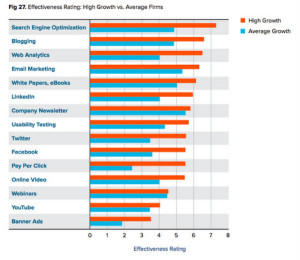 Today’s guest post is by Lee Frederiksen.
Today’s guest post is by Lee Frederiksen.
According to the Hinge Research Institute, 66 percent of professional services firms plan to increase spending on digital marketing within the next year.
But with so many online marketing channels available today, where will that money go?
Some firms will invest heavily in their social media presence, they’ll hire new young talent or contract the job to marketing companies.
Some will stick to good old fashioned email marketing, which is a proven tactic for reaching targeted eyeballs.
Others will diversify their budgets, allocating their marketing dollars across a panoply of tactics to cover all bases.
Because there is no shortage of options for reaching prospects online, the decision-making process for marketers is complex.
The research study from Hinge dug a bit deeper in an attempt to determine which online marketing tactics were most effective for high-growth professional services firms. The study surveyed 500 firms and segmented the results into two groups: Average growth firms and high-growth firms (growth was determined by year-over-year revenue).
Here’s a look at how high-growth firms rated various marketing technique in terms of effectiveness on a 0 (worst) to 10 (best) scale:
The first thing you may notice is, across the board high growth firms seem to be getting more out of online marketing. What’s more interesting, however, is which tactics sit at the top of the list: SEO, blogging, and web analytics.
While it’s true social media marketing is an important part of online marketing for professional services, it doesn’t appear to be the most important component. So before you commit time and money to building your Twitter following, you may want to beef up your content creation and search traffic.
Decide Where to Invest Your Online Marketing Dollars
If you decide to invest in online marketing, follow these three steps.
1. Build an SEO Foundation. Even professional services buyers are looking for your services with search engines. To give your firm a chance to make it into top search results for key terms, you must dedicate resources to SEO on a continual basis.
At a high level, the process looks like this:
- Conduct keyword research to understand what relevant terms people are searching for;
- Create valuable content on your website that focuses on selected words and phrases; and
- Build authority and increase rankings over time by attracting inbound links from other websites.
Many firms will ignore SEO because they don’t understand it. Well, it’s time to start understanding. Work with an SEO professional and begin attracting new leads through your website.
2. Consistently Create Niche Content. Think of your website as a magnet. Your job is to attract people and pull them into your site. A proven way to accomplish this goal is to publish high-quality, educational content for your target audience on a consistent basis. A common medium for content publication is blogging, but education can come in many formats, such as whitepapers, ebooks, research reports, videos, and infographics.
Here are just a few of the benefits of creating content that targets your niche audience:
- If your content is keyword rich, it has a good chance of ranking well in search engines and pulling in targeted traffic. SEO and content go hand-in-hand.
- Helpful content instills trust. By assisting your audience throughout the buying process you are gradually building a relationship.
- Great content attracts links from other websites. These links generate both referral and search traffic (in general, the more high-quality links your site has, the more credibility Google gives it).
- More substantial content, such as a whitepaper, can be used to generate leads. Often firms will require a visitor to supply their email address before they can download a piece.
3. Measure, Report, and React. Web analytics are easy to overlook when you’re busy. But reviewing important metrics on a weekly or monthly basis provides the insights you need to make critical decisions about your online marketing. How else will you know which marketing tactics are working and which aren’t?
Which metrics to measure will depend on your strategy. Here are a few that will almost always be useful:
- Traffic by Source: Understanding where your web traffic is coming from and how it is performing is key to evaluating your marketing efforts. Note which websites and keywords are sending traffic to you and how long those visitors are staying on your site.
- Conversions by Source: A conversion action is a specific goal you want your visitors to accomplish while on the site. Examples include downloading an ebook or filling out a contact form. By analyzing where these conversions came from (Google vs. LinkedIn vs. another website) you will start to recognize your best lead sources.
- Pageviews: By looking at the number of pageviews per visit, you will be able to identify your most popular web pages. Common best performers are the home, about, and services pages. But as you publish quality educational content on your site, expect to see the majority of your traffic coming to content pages, such as blog posts, ebooks, and articles.
In your online marketing, where do you see the most value?
Lee Frederiksen is the managing partner at Hinge, a company that specializes in branding and marketing for professional services firms. He also co-authored the Hinge ebook Online Marketing for Professional Services.
